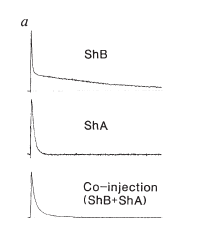
Evidence for the formation of heteromultimeric potassium channels in Xenopus oocytes
Abstract
Potassium channels show a wide range of functional diversity. Nerve cells typically express a number of K+. channels that differ in their kinetics, single-channel conductance, pharmacology, and sensitivity to voltage and second messengers. The cloning of the Shaker gene in Drosophila, and of related genes, has revealed that the encoded K+ channel polypeptides resemble one of the four internally homologous domains of the alpha-subunits of Na+ channels and Ca2+ channels, indicating that K+ channels may form by the co-assembly of several polypeptides. In this report we provide evidence that the Shaker A-type K+ channels expressed in Xenopus oocytes contain several Shaker polypeptides, that heteromultimeric channels may form through assembly of different channel polypeptides, that the kinetics or pharmacology of some heteromultimeric channels differ from those of homomultimeric channels, and that channel polypeptides from the fruit fly can co-assemble with homologous polypeptides from the rat. We suggest that heteromultimer formation may increase K+ channel diversity beyond even the level expected from the large number of K+ channel genes and alternative splicing products.